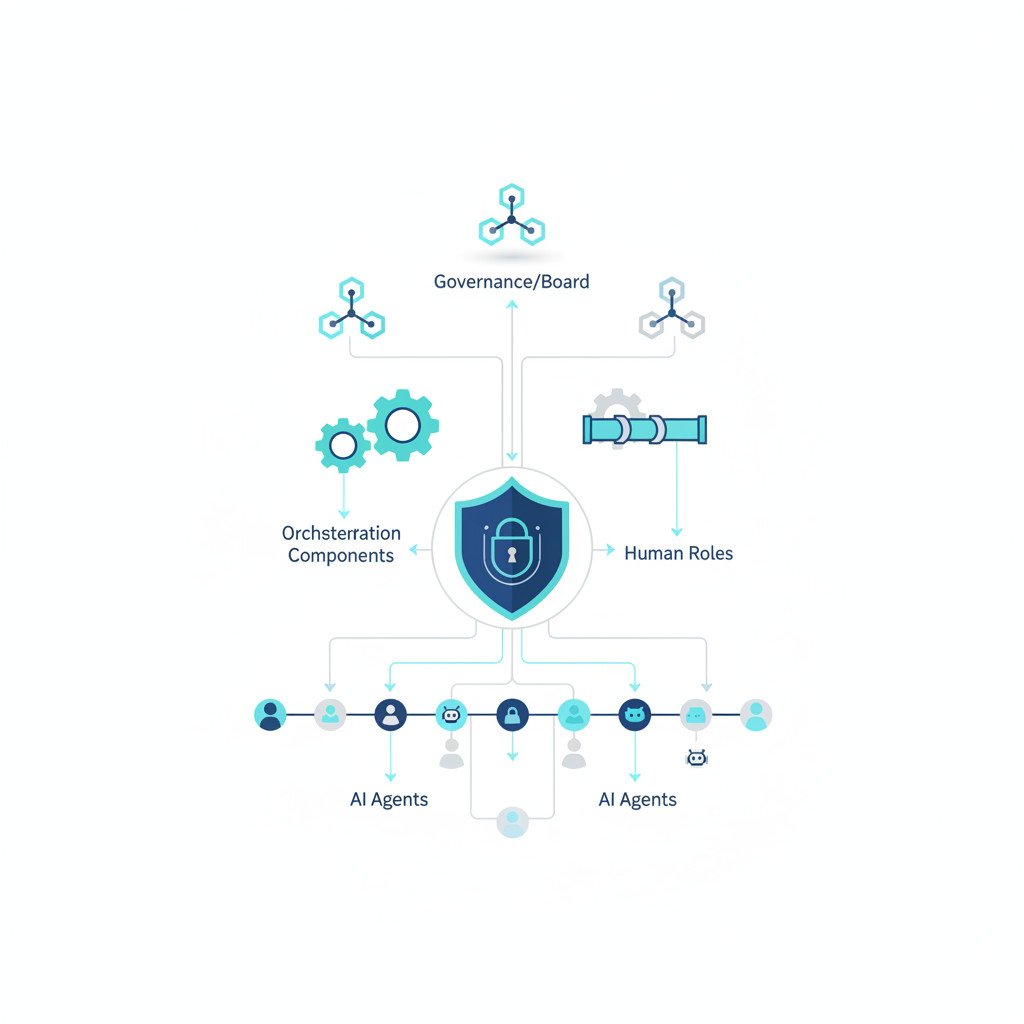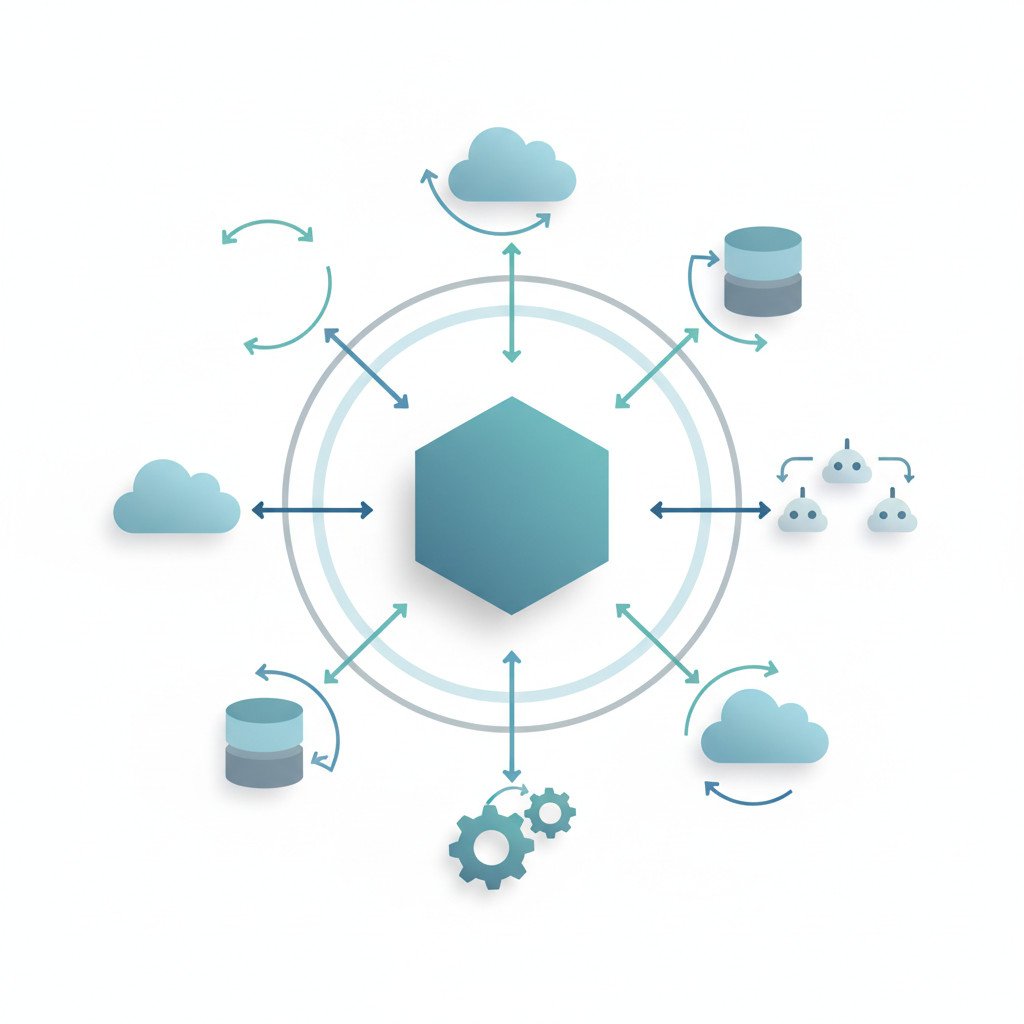Agentic AI Readiness: Governance, Orchestration, and Non-AI Work for Enterprise Success
Agentic AI readiness is the new imperative.
It means preparing people, processes, and data for AI agents that act with autonomy. Because agents change how tasks flow, they require clear rules and reliable inputs. Therefore governance, tool orchestration, and human work redesign must align.
This introduction explores what readiness looks like in practice. We will examine governance models that reduce risk and increase trust. Next, we cover orchestration approaches that coordinate agents, LLMs, and legacy systems. Finally, we discuss non-AI work such as change management, skills, and process design.
Readers will find practical frameworks and questions for leaders. As a result, teams can scale automation while guarding privacy and data quality. However, success depends on collaboration between IT, risk, and business owners. The rest of the article lays out concrete steps to move from pilot to production.
We also tackle practical risks such as bias, security, and cost control. Because data quality shapes agent outputs, the article highlights data governance practices. Moreover, we outline human workflows that remain essential even as agents automate tasks. By the end, leaders will have a roadmap to build trustworthy, scalable agentic AI. Start with pilots that tie agents to clear business outcomes.
Agentic AI readiness: governance, orchestration, and non-AI work for enterprise success
Agentic AI readiness means more than deploying smart agents. It requires aligning rules, systems, and people so agents act safely and reliably. Because agents can make autonomous decisions, enterprises must design clear guardrails. Therefore governance, orchestration, and non-AI work form the readiness backbone.
Core components at a glance
- Governance: Establish policies, accountability, and auditing for agent behavior. Include data governance, model validation, privacy controls, and compliance checks. For context on common integration failures and governance gaps, see research and industry findings from UiPath and other analysts like Forrester.
- Orchestration: Coordinate multiple agents, LLMs, and legacy systems across end-to-end workflows. Use robust APIs, retry logic, and centralized observability. Orchestration reduces failures and improves automation ROI.
- Non-AI work: Redesign roles, retrain staff, and document processes. Change management, upskilling, and process mapping remain business-critical because humans will validate, monitor, and tune agent behavior.
Why each component matters
- Governance protects trust. Without it, agents can amplify bias or leak data, and that creates regulatory and reputational risk. As a result, teams must monitor outputs and log decisions.
- Orchestration enables scale. When orchestration fails, pilots stall and costs rise. Therefore invest in tooling that indexes tasks, tracks state, and routes exceptions.
- Non-AI work ensures sustainability. Teams need clear ownership, playbooks, and continuous training so agents augment rather than replace critical judgment.
Quick checklist to prepare for deeper sections
- Define ownership for policies and agent outcomes
- Map key workflows and data quality gaps
- Select orchestration patterns and observability metrics
- Build a change plan with skill milestones and governance signoffs
For practical frameworks and technical patterns, later sections dig into governance models, orchestration architectures, and the non-AI tasks leaders cannot outsource. In the meantime, consider vendor guidance from cloud providers and enterprise automation vendors to shape your roadmap.

AI governance in the enterprise: policies, ethics, risk, and compliance
AI governance defines the rules and responsibilities that guide agentic systems. Because agents act autonomously, governance keeps decisions aligned with law, policy, and values. Therefore effective governance reduces risk and increases trust across stakeholders.
Start with clear policies
- Policy scope: Define which agents and workflows fall under governance.
- Roles and ownership: Assign policy owners, reviewers, and incident responders.
- Model lifecycle rules: Specify development, validation, deployment, and retirement controls.
These policies should link to data governance and access controls. For example, require documented data lineage and versioning. As a result, teams can trace outputs back to inputs and models.
Embed ethical frameworks
- Principle statements: State fairness, transparency, privacy, and safety goals.
- Decision boundaries: Set limits on where agents may act without human approval.
- Accountability channels: Provide ways to appeal or override agent decisions.
“An AI agent is only as good as the data it runs on. Clean, reliable, and well governed data ensures decisions are accurate and outputs are trustworthy.” This truth underpins ethical rules and testing.
Manage risk with continuous oversight
- Risk inventory: Catalog risks by business impact and likelihood.
- Monitoring: Implement real time logs, alerting, and drift detection.
- Testing: Use scenario tests, adversarial checks, and red teams before release.
Because 95 percent of generative AI pilots fail due to flawed integration, good governance must focus on realistic workflow tests. See industry analyses for integration challenges and best practices. For practical vendor guidance and automation research, consult UiPath and Forrester.
Compliance and regulatory readiness
- Mapping: Align agent behaviors to legal and regulatory requirements.
- Evidence: Keep auditable logs for model decisions, data access, and change history.
- Reporting: Build templates for internal review and external audits.
Compliance is not a one time task. Instead, make it part of the deployment lifecycle so teams stay ahead of new laws.
Operational practices that work
- Lightweight governance boards for rapid decisions.
- Centralized policy repository with easy search.
- Playbooks for incidents, bias remediation, and rollback.
“Your leadership is especially critical in making sure that your business has an AI strategy that addresses both the opportunity and the risk,” says Eddie Kim. Therefore leaders must fund governance and enforce accountability.
In short, governance blends policy, ethics, risk controls, and compliance into a living system. When done right, governance accelerates safe adoption and scales agentic AI across the enterprise.
Compare governance frameworks and orchestration tools
Below is a concise comparison of common governance frameworks and orchestration tools that matter for agentic AI readiness. Because choices shape scale and risk, use this table to match needs to tools and frameworks.
| Name | Key features | Benefits | Typical use cases |
|---|---|---|---|
| NIST AI Risk Management Framework | Risk taxonomy, iterative lifecycle, maturity tiers, guidance for measurement and controls | Standardized risk language, better audit readiness, practical controls for enterprises | Risk assessment, policy design, cross team alignment |
| ISO 42001 AI management system | Management system approach, documented processes, continuous improvement and audit focus | Certification path, formal governance, supplier oversight | Compliance programs, enterprise governance, vendor management |
| OECD AI Principles | High level ethics principles covering fairness, transparency and accountability | Executive level alignment, public trust, simple policy anchor | Ethics policies, training, stakeholder communications |
| Microsoft Responsible AI toolkit | Checklists, fairness and interpretability tools, monitoring guidance | Developer level guidance, built in testing, integration with cloud services | Model validation, fairness audits, production monitoring |
| ModelOps platforms eg MLflow Kubeflow | Model versioning, experiment tracking, CI CD for models, reproducibility controls | Faster deployments, reproducible experiments, rollback capability | ML lifecycle management, production model operations |
| Workflow orchestrators eg Apache Airflow Prefect | Task orchestration, scheduling, dependency management, retries and observability | Reliable pipelines, error handling, clear retry policies | Data pipelines, batch jobs, ML pipeline scheduling |
| Agent orchestration tools eg LangChain Ray AWS Step Functions | Multiple model coordination, state management, chaining and scaling capabilities | Coordinate LLMs and agents, manage long running state, autoscale workloads | Agentic workflows, conversational automation, multi model flows |
| Data governance platforms eg Collibra Alation | Data cataloging, lineage tracking, policy enforcement and access controls | Improved data quality, traceability for audits, easier discovery | Data readiness, lineage for audits, access control enforcement |
Use this table to pick a framework or toolset that matches regulatory needs operational model and scale. Therefore combine governance frameworks with orchestration and data tooling to cover policy people and technology.

AI orchestration and its role in agentic AI readiness
Orchestration coordinates models, agents, and systems so workflows run smoothly. In agentic environments, orchestration manages state, routing, and retries. Therefore orchestration becomes the backbone that connects agents to business processes.
Orchestration supports seamless workflow integration in several ways. First, it normalizes inputs and outputs across tools. Next, it tracks state across long running tasks. As a result, teams see fewer errors and faster cycle times.
Practical examples show the value. For example, an energy company reduced threat detection from hours to minutes by linking sensors, models, and incident tooling. In another case, a legal team saved millions by integrating document AI into review pipelines. These outcomes require orchestration that ties agents to existing systems and human reviewers. For context on why integration matters, see the MIT study summarized by Computerworld that links failure to poor workflow integration at scale. Computerworld Study.
Key orchestration capabilities
- State management: Preserve context for multi step tasks and long transactions.
- Routing and choreography: Send work to the right agent, model, or human reviewer.
- Observability: Log events, trace decisions, and surface bottlenecks for troubleshooting.
- Error handling: Apply retry logic, compensation steps, and human escalation.
Benefits that matter to enterprises
- Faster time to value because workflows stay reliable and repeatable.
- Better risk control because observability reveals drift and anomalies.
- Improved scalability because orchestration can autoscale agents and compute.
- Higher adoption because integrated flows fit into users work patterns.
Common challenges and how to address them
- Legacy integration complexity can stall projects. Therefore invest in API layers and adapters.
- State explosion across agents creates debugging difficulty. Use centralized state stores and tracing tools.
- Cost can grow with many models and calls. Consequently apply cost governance and rate limits.
- Security and data flow concerns require strict access controls and encryption.
Tooling choices depend on needs. For agent coordination, frameworks like LangChain offer patterns for chaining models. See LangChain documentation at LangChain Documentation. For serverless orchestration, consider services such as AWS Step Functions for complex workflows. AWS Step Functions.
Orchestration turns isolated AI capabilities into dependable business automation. As a result, organizations that pair orchestration with governance and human centered design unlock scalable agentic AI.
Non-AI work: human oversight, culture, and change management
People and process work remain central to agentic AI readiness. Because agents change decision pathways, enterprises must redesign roles and workflows. Therefore human oversight, cultural readiness, training, and change management are critical.
Human oversight and role redesign
- Human in the loop: Define when humans must review agent decisions. This reduces risk and preserves judgment.
- Role redefinition: Update job descriptions so people manage exceptions and tune agents.
- Ownership: Assign clear owners for agent outcomes, data quality, and incident response.
“Your leadership is especially critical in making sure that your business has an AI strategy that addresses both the opportunity and the risk,” says Eddie Kim. Hence leaders must sponsor training and governance budgets.
Cultural readiness and trust
- Mindset shift: Encourage experimentation while enforcing guardrails.
- Transparency: Share how agents make decisions and when to escalate.
- Psychological safety: Reward reporting of agent failures and near misses.
“Agentic AI transforms how work gets done, so cultural readiness is essential.” This means frontline teams must trust agents before they adopt them broadly.
Training and upskilling
- Fluency programs: Teach staff how to use agents safely and to verify outputs.
- Role based training: Offer different tracks for developers, reviewers, and business owners.
- Practice labs: Run sandbox environments where teams practice real scenarios.
Fact: Leadership must upskill the workforce for AI fluency. As a result, pilots scale faster and recover from failures more quickly. For example, enterprise upskilling programs have shown measurable improvements in adoption and performance. See UiPath research on agentic AI adoption for further context.
Change management and operational readiness
- Communication plan: Announce goals, timelines, and expected role changes.
- Process mapping: Document current and future state workflows before deployment.
- Playbooks: Build step by step guides for incidents, rollbacks, and bias remediation.
Finally, non-AI work focuses on sustaining agentic systems. Without human oversight and cultural alignment, agents can drift or cause harm. Consequently, invest in people as much as technology to ensure enterprise success.
Agentic AI readiness matters because governance, orchestration, and non-AI work together to decide success or failure.
Organizations that invest in clear policies, robust orchestration, and human-centered change scale safely. As a result, they reduce risk, lower costs, and speed time to value. Because agents act autonomously, leadership must fund governance, define ownership, and support workforce fluency.
EMP0 helps enterprises build this readiness. We deliver AI and automation advisory, end-to-end orchestration designs, data governance frameworks, and hands-on implementation. In addition, we run pilot programs and upskilling tracks so teams adopt agents with confidence. Our offerings include strategy workshops, governance playbooks, orchestration blueprints, and production support to move pilots into sustainable operations.
Find EMP0 online to learn more about our approach. Visit our website at emp0.com and explore practical case studies on our blog at articles.emp0.com. Follow updates and short posts via our social handle X at @Emp0_com, read deeper essays on Medium at medium.com/@jharilela, and see automation recipes on n8n at n8n.io/creators/jay-emp0.
Start with a focused pilot that pairs governance and orchestration with human oversight. If you want help, EMP0 can assess your readiness, design a checklist, and run the first pilot with measurable guardrails.
Take the next step: align policy, people, and platforms now to unlock the full potential of agentic AI.

